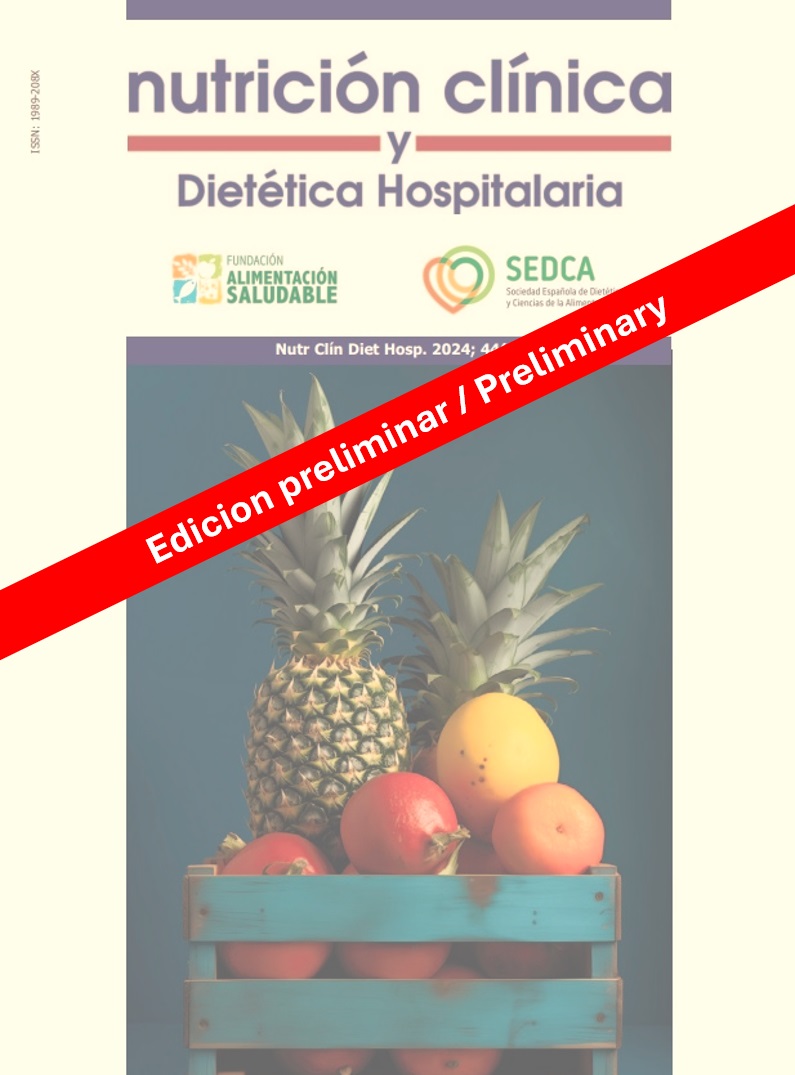Hospital malnutrition in gastro-entero-hepatology (GEH) patients and its relationship to clinical outcomes: a retrospective cohort study.
DOI:
https://doi.org/10.12873/451mayaPalabras clave:
Malnutrition, Gastro-entero- hepatology, Hospitalization, Nutritional Support, Inflammatory MarkersResumen
Background: Hospital malnutrition remains a significant global health burden, particularly among gastro-entero-hepatology patients. It adversely impacts clinical outcomes, prolongs hospital stays, and raises healthcare costs. Despite its relevance, recent data on malnutrition among Indonesia’s gastro-entero-hepatology (GEH) patients are limited.
Objective: To determine the prevalence of malnutrition and its associated risk factors and clinical outcomes, inflammatory markers, and Prognostic Nutritional Index (PNI) in GEH patients at Wahidin Sudirohusodo General Hospital.
Methods: A retrospective cohort study was conducted among 569 GEH inpatients aged 18–59 years with hospital stays exceeding 7 days. Nutritional risk was assessed using the Malnutrition Screening Tool (MST), while Neutrophil-Lymphocyte Ratio (NLR), Total Lymphocyte Count (TLC), and Prognostic Nutritional Index (PNI) were measured as inflammatory markers. Statistical analyses evaluated correlations between malnutrition risk, clinical outcomes, and laboratory values.
Results: Of the 569 patients, 7.4% were at high risk of malnutrition, 38.7% at moderate risk, and 54% at low risk. High-risk patients showed significantly elevated NLR (p = 0.000) and lower TLC (p = 0.000), reflecting an impaired immune response. These patients also had a lower PNI (p = 0.000) and more extended hospital stays (p = 0.000). No significant difference in mortality was found between different malnutrition risk groups.
Conclusion: Malnutrition is prevalent among GEH patients, particularly those with malignancies. Early nutritional screening and appropriate interventions are essential to improving clinical outcomes and reducing hospital stay durations. A multidisciplinary approach is necessary to optimize patient care.
Referencias
Bellanti F, Lo Buglio A, Quiete S, Vendemiale G. Malnutrition in hospitalized old patients: screening and diagnosis, clinical outcomes, and management. Nutrients. 2022;14(4):910. DOI: https://doi.org/10.3390/nu14040910
Menteri Kesehatan Republik Indonesia. Pedoman Nasional Pelayanan Kedokteran Tatalaksana Malnutrisi Dewasa [Internet]. 2019 [cited 2024 Sep 16]. Available from: https://yankes.kemkes.go.id/unduhan/fileunduhan_1610416412_498969.pdf
Reber E, Gomes F, Vasiloglou MF, Schuetz P, Stanga Z. Nutritional risk screening and assessment. J Clin Med. 2019;8(7):1065. DOI: https://doi.org/10.3390/jcm8071065
Cass AR, Charlton KE. Prevalence of hospital‐acquired malnutrition and modifiable determinants of nutritional deterioration during inpatient admissions: A systematic review of the evidence. Journal of Human Nutrition and Dietetics. 2022;35(6):1043–58. DOI: https://doi.org/10.1111/jhn.13009
Langley-Evans SC. Nutrition screening tools: still no consensus 40 years on. Vol. 34, Journal of human nutrition and dietetics: the official journal of the British Dietetic Association. 2021. p. 923–5. DOI: https://doi.org/10.1111/jhn.12952
Ringel JB, Jannat-Khah D, Chambers R, Russo E, Merriman L, Gupta R. Impact of gaps in care for malnourished patients on length of stay and hospital readmission. BMC Health Serv Res. 2019;19:1–6. DOI: https://doi.org/10.1186/s12913-019-3918-3
Norman K, Kirchner H, Lochs H, Pirlich M. Malnutrition affects the quality of life in gastroenterology patients. World journal of gastroenterology: WJG. 2006;12(21):3380. DOI: https://doi.org/10.3748/wjg.v12.i21.3380
Keller U. Nutritional laboratory markers in malnutrition. J Clin Med. 2019;8(6):775. DOI: https://doi.org/10.3390/jcm8060775
Merker M, Felder M, Gueissaz L, Bolliger R, Tribolet P, Kägi-Braun N, et al. Association of baseline inflammation with the effectiveness of nutritional support among patients with disease-related malnutrition: a secondary analysis of a randomized clinical trial. JAMA Netw Open. 2020;3(3):e200663–e200663. DOI: https://doi.org/10.1001/jamanetworkopen.2020.0663
Kaya T, Açıkgöz SB, Yıldırım M, Nalbant A, Altaş AE, Cinemre H. Association between neutrophil‐to‐lymphocyte ratio and nutritional status in geriatric patients. J Clin Lab Anal. 2019;33(1):e22636. DOI: https://doi.org/10.1002/jcla.22636
Rocha NP, Fortes RC. Total lymphocyte count and serum albumin as predictors of nutritional risk in surgical patients. ABCD Arquivos Brasileiros de Cirurgia Digestiva (São Paulo). 2015;28(3):193–6. DOI: https://doi.org/10.1590/S0102-67202015000300012
Marín-Castro AE, Ortiz-Espinel DO, Sánchez-Toro CA, Zapata-Acevedo CM, Marín- Castro MJ, Conde-Rodríguez BD, et al. Relationship of the prognostic nutritional index with complications and mortality in patients with gastric cancer who underwent gastrectomy in a tertiary hospital in Bogotá, Colombia. Revista Colombiana de Cirugía. 2022;37(1):60– 71. DOI: https://doi.org/10.30944/20117582.951
Wu M, Zhu Y, Chen X, Wang X, Lin X, Yan X, et al. The prognostic nutritional index predicts the prognosis of patients with advanced esophageal cancer treated with immune checkpoint inhibitors: a retrospective cohort study. J Gastrointest Oncol. 2023;14(1):54. DOI: https://doi.org/10.21037/jgo-23-48
Correia MITD, Perman MI, Waitzberg DL. Hospital malnutrition in Latin America: A systematic review. Clinical nutrition. 2017;36(4):958–67. DOI: https://doi.org/10.1016/j.clnu.2016.06.025
Beghetto MG, Koglin G, Mello ED de. Influence of the assessment method on the prevalence of hospital malnutrition: a comparison between two periods. Nutricion hospitalaria Madrid Vol 25, no 5 (2010), p 774-780. 2010;
Molas MT, Farré CV, Talaveron JML, Badosa EL, Tahull MB, Casas NV, et al. Hospital malnutrition screening at admission: malnutrition increases mortality and length of stay. Nutr Hosp. 2017;34(4):907–13.
Abrha MW, Seid O, Gebremariam K, Kahsay A, Weldearegay HG. Nutritional status significantly affects hospital length of stay among surgical patients in public hospitals of Northern Ethiopia: single cohort study. BMC Res Notes. 2019;12:1–6. DOI: https://doi.org/10.1186/s13104-019-4451-5
Barker LA, Gout BS, Crowe TC. Hospital malnutrition: prevalence, identification, and impact on patients and the healthcare system. Int J Environ Res Public Health. 2011;8(2):514–27. DOI: https://doi.org/10.3390/ijerph8020514
Gomes F, et al. Association of Nutritional Support With Clinical Outcomes Among Medical Inpatients Who Are Malnourished or at Nutritional Risk An Updated Systematic Review and Meta-analysis. 2022.
İğde MH, Oruç Ö, Kocatepe V. The Correlation of Malnutrition with Mortality and Morbidity According to Global Initiative on Malnutrition Criteria in the Palliative Care Unit. Florence Nightingale J Nurs. 2023;31(Suppl 1):7. DOI: https://doi.org/10.5152/FNJN.2023.23062
Patel J, Bains K, Kalra S, Singh I, Kohli I, Dukovic D, et al. The Effects of Malnutrition on Inpatient Outcomes in Patients With Gastroparesis: A Nationwide Analysis. Cureus. 2023;15(10). DOI: https://doi.org/10.7759/cureus.47082
Elia M. Defining, recognizing, and reporting malnutrition. Int J Low Extrem Wounds. 2017;16(4):230–7. DOI: https://doi.org/10.1177/1534734617733902
Descargas
Publicado
Licencia
Derechos de autor 2025 Nutrición Clínica y Dietética Hospitalaria

Esta obra está bajo una licencia internacional Creative Commons Atribución-NoComercial-SinDerivadas 4.0.
Los lectores pueden utilizar los textos publicados de acuerdo con la definición BOAI (Budapest Open Access Initiative)







